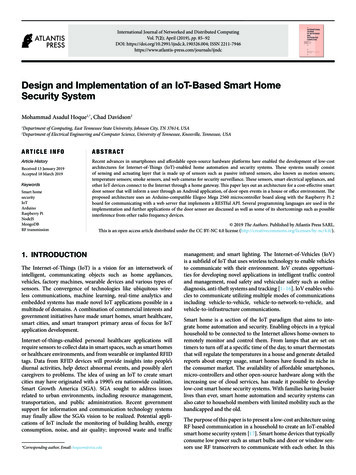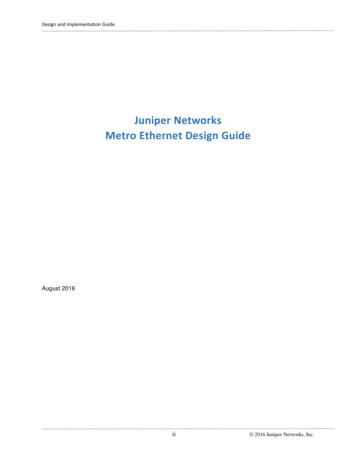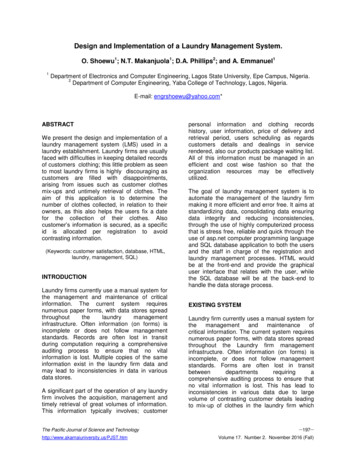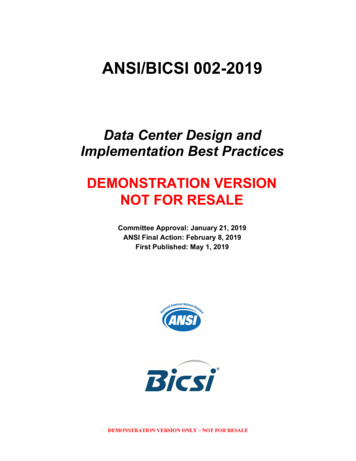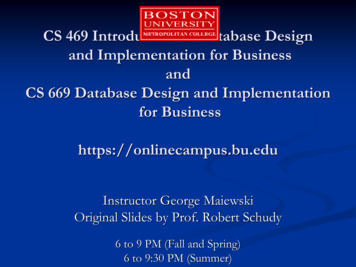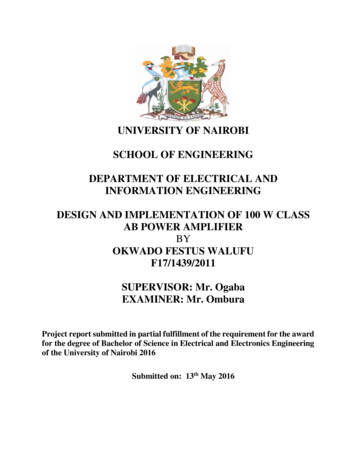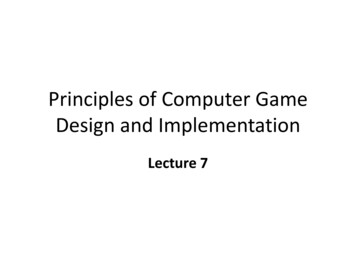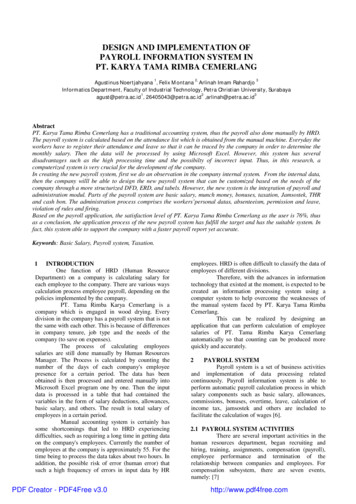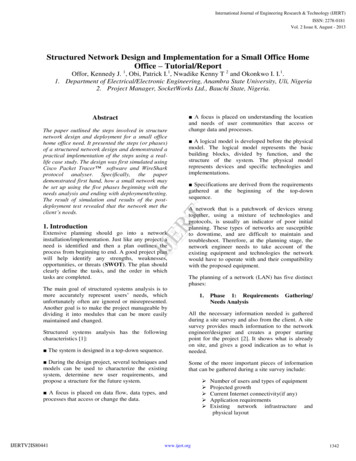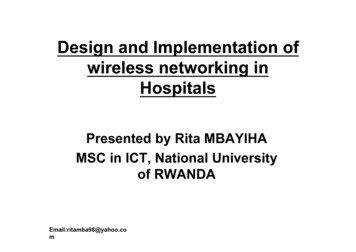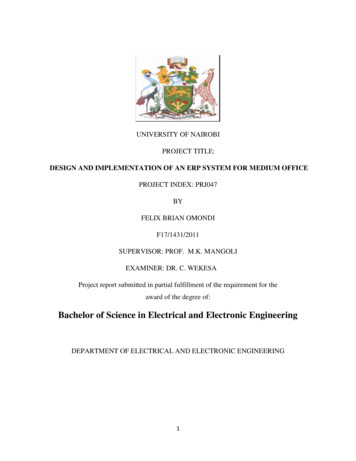
Transcription
UNIVERSITY OF NAIROBIPROJECT TITLE:DESIGN AND IMPLEMENTATION OF AN ERP SYSTEM FOR MEDIUM OFFICEPROJECT INDEX: PRJ047BYFELIX BRIAN OMONDIF17/1431/2011SUPERVISOR: PROF. M.K. MANGOLIEXAMINER: DR. C. WEKESAProject report submitted in partial fulfillment of the requirement for theaward of the degree of:Bachelor of Science in Electrical and Electronic EngineeringDEPARTMENT OF ELECTRICAL AND ELECTRONIC ENGINEERING1
DECLARATION OF ORIGINALITY1) I understand what plagiarism is and I am aware of the university policy in this regard.2) I declare that this final year project report is my original work and has not been submittedelsewhere for examination, award of a degree or publication. Where other people’s work or myown work has been used, this has properly been acknowledged and referenced in accordancewith the University of Nairobi’s requirements.3) I have not sought or used the services of any professional agencies to produce this work4) I have not allowed, and shall not allow anyone to copy my work with the intention of passingit off as his/her own work.5) I understand that any false claim in respect of this work shall result in disciplinary action, inaccordance with University anti-plagiarism policy.Signature: Date: 2
DEDICATION.I dedicate this project to my adorable, loving and zealous father, my uncles Lawrence andSamson, and my sisters Belin and Marceline.Thank you for your unwavering love and support.3
ACKNOWLEDGEMENT.I would like to acknowledge the department of Electrical and Information Engineering forcoming up with this project. I thank my supervisor, Prof. Mangoli for guiding me throughout thisendeavor. His insightful guidance cannot go unmentioned.I would also like to thank my family for their support and ensuring I had everything to facilitatemy completion of this degree program.I would also like to thank my friends and fellow classmates who encouraged and motivated meduring the time I was carrying out this project.Last but not least, I would like to thank God for the gift of life and health as well as all theblessings he has showered upon me to enable me finish this project.4
TABLE OF CONTENTSDECLARATION OF ORIGINALTY 2DEDICATION .3ACKNOWLEDGEMENT .4LIST OF TABLES, GRAPHS AND IMAGES .7ABSTRACT .8CHAPTER 1 .91.1 INTRODUCTION 91.2 PROBLEM STATEMENT 101.3 OBJECTIVE .10CHAPTER 2 .112.1 LITERATURE REVIEW .112.2 UNDERSTANDING ERP .112.3 ERP CHARACTERISTICS .132.4 ERP MODULES 142.4.1 BUSINESS MODULES .142.4.2 EVENT-BASED MODULES .162.5 ERP SYSTEMS AND ERP SYSTEMS ADOPTION .172.6 CRITICAL SUCCESS FACTORS FOR ERP SYSTEM IMPLEMENTATION .192.7 BENEFITS OF ERP IMPLEMENTATION AND USE 24CHAPTER 3 .263.1 DESIGN .263.1.1 PARKING .265
3.1.2 ENTRANCE .263.1.3 RESTRICTED AREAS .273.1.4 SURVEILLANCE .273.2.1 METHODOLOGY .323.2.1 XAMPP .323.2.2 CODEIGNITER .333.2.2.1 APPLICATION FLOW .333.2.2.2 CREATING DATABASE .343.2.2.3 CONNECTING CODEIGNITER TO DATABASE .353.3 CONSTRUCT 2 .35CHAPTER 4 .374.1 RESULTS .37CHAPTER 5 .405.1 CONCLUSION AND RECOMMENDATION .40REFERENCES .41APPENDIX .436
LIST OF TABLES, GRAPHS AND IMAGES2.7 DIMENSIONS OF ERP SYSTEMS BENEFITS .253.1 GEDOX ORGANIZATIONAL FLOWCHART .283.1.1 PARKING FLOWCHART .293.1.2 ENTRANCE FLOWCHART .303.1.3 RESTRICTED AREAS FLOWCHART .313.1.4 SURVEILLANCE FLOWCHART .314.1 SCREENSHOTS 387
ABSTRACTThis project will endeavor to design and implement an ERP system for a medium office. It willdo so by first defining what a medium office is and choosing an organizational structure whichmatches that definition. Different events taking place in the organization will be analyzed andfrom this an ERP system that focusses on these events will be developed. The event-driven ERPsystem will be built using a number of application development tools as well as differentprogramming languages. This system will focus on surveillance and access control of theorganization.8
CHAPTER 1.1.1 INTRODUCTIONAn enterprise resource planning (ERP) software is an enterprise-wide application softwarepackage that integrates all necessary business functions into a single system with a commondatabase. Enterprise resource planning (ERP) systems integrate and streamline the businessprocesses of an organization across departmental and geographical borders.In its basic definition, ERP is an enterprise-wide information system that integrates and controlsall the business and technological processes in the entire organization. According to Chung &Snyder (2000), ERP is “a packaged business software system that enables a company to managethe efficient and effective use of resources (materials, human resources, finance, etc.) byproviding a total, integrated solution for the organization’s information-processing needs”. Thissoftware facilitates, if well-implemented, the integration of all the functional information flowsacross the organization into a single package with a common database. Therefore, it allows easyand immediate access to information regarding inventory, product or customer data, prior historyinformation, parking space, surveillance and access controlToday, many public and private organizations worldwide are implementing ERP systems inplace of the functional legacy systems that are not anymore well-compatible with modernbusiness environment. However, according to Ahituv et al., (2002), the process of moving fromfunctional applications to an ERP system is difficult and challenging. Additionally, the switch toERP system is expensive and it requires development of new procedures, training and convertingdata. Enterprise resource planning systems, also called enterprise systems (ES) are among themost important business information technologies that emerged during the last decade. While notwo industries’ ERP systems are the same, the basic concept of ERP systems is focused onstandardization and synchronization of information, and as a result, improved efficiency. Thebenefits of ERP systems include coordinating processes and information, reducing carryingcosts, decreasing cycle time, and improving responsiveness to customer needs.The business environment is dramatically changing. Companies today face the challenge ofincreasing competition, expanding markets, meeting customer expectations and improving9
security in the office environment. This increases the pressure on companies to lower total costsin the entire supply chain, shorten throughput times, drastically reduce inventories, expandproduct choice, provide more reliable delivery dates and better customer service, improvequality, and efficiently coordinate global demand, supply, and production. As the business worldmoves ever closer to a completely collaborative model and competitors upgrade theircapabilities, to remain competitive, organizations must improve their own business practices andprocedures. Companies must also increasingly share with their suppliers, distributors, andcustomers the critical in-house information they once aggressively protected. And functionswithin the company must upgrade their capability to generate and communicate timely andaccurate information. To accomplish these objectives, companies are increasingly turning toenterprise resource planning (ERP) systems. ERP provides two major benefits that do not exist innon-integrated departmental systems: (1) a unified enterprise view of the business thatencompasses all functions and departments; and (2) an enterprise database where all businesstransactions are entered, recorded, processed, monitored, and reported. This unified viewincreases the requirement for, and the extent of, interdepartmental cooperation and coordination.1.2 PROBLEM STATEMENTWhen a business grows beyond a certain a level, it becomes tedious and complicated to followup all the processes taking place in it. Not only is it difficult to follow up the business processesof the organization such as accounting and inventory, it also becomes quite difficult to keep trackof events such as parking and entry of people into the organization.The events taking place in the organization can be tracked through surveillance and accesscontrol. This calls for the use of an event-based ERP system. It is a system that automates anumber of events taking place in the organization such as parking and employee entry. Thisproject set out to develop such a system.1.3 OBJECTIVEThe project is meant to design and implement an Enterprise Resource Planning system for amedium office. This will be achieved in two steps as follows:10
Defining what a medium office is and coming up with the structure and operations of thatoffice Designing and implementing an event-based ERP system for the organization based onthe operations identified above.11
CHAPTER 22.1LITERATURE REVIEWThe following section first explains the evolution of ERP system and some of its characteristics.It also explores the various modules available in an ERP software. Knowledge-intensive natureof ERP systems and ERP system adoption is also analyzed. Finally it looks into critical successfactors for ERP system implementation as well as benefits of ERP implementation and use.2.2 UNDERSTANDING ERPThe first part of this section describes the evolution, characteristics, and various definitions ofERP systems.Most research studies view the evolution of ERP systems from a manufacturing perspective. Inthe late 1950s and the early 1960s, automated reorder point (ROP) systems were used forscheduling production, ordering materials, and shipping products within an assigned plant area.During the mid-1960s, computerized materials requirements planning (MRP) systems began toreplace ROP systems. These systems represented the first off-the-shelf business applicationsystems available in the market. They supported the creation and maintenance of master data andbill of materials (BOM) across all products and parts in one or more plants. BOM processors andforecasting algorithms along with computerized production reporting tools formed typical partsof the MRP system (Ahituv et al., 2002).In the mid-1970s, manufacturing resources planning (MRP II) systems began to replace MRPsystems. MRP II systems integrated materials as well as production capacity requirements in thecalculation of overall production capabilities. In addition, advanced reporting capabilitiesenabled the efficient scheduling and monitoring the execution of production plans. The ITunderlying MRP and MRP II systems focused primarily on automating transactions in order toincrease the firm’s operational efficiency (Poston & Grabski, (2001)).The MRP systems typically ran on mainframes, reflected centralized computing, involvedlimited interactions between users and the system, and had low levels of functional integration.12
The MRP II systems, in contrast, mainly used multi-user networks and ran on a variety of ITplatforms. The late 1980s witnessed rapid advances in technology and MRP II systems wereintegrated with other systems such as computer integrated manufacturing (CIM), just-in-time(JIT), electronic data interchange (EDI), and manufacturing execution systems (Light et al.2001).In the early 1990s, ERP systems replaced MRP II systems. ERP systems extended MRP IIsystem functionalities to include functions such as human resources, sales and distribution, andquality to create seamless, integrated information flows across the entire firm. ERP systemscomprise of a suite of integrated products that use a common IT architecture and can be linked orde-linked and integrated with legacy and other application systems. These systems run onmultiuser networks and allow the simultaneous aggregation, de-aggregation, and manipulation ofreal- 6 time data across functions. ERP systems now form the IT backbone of firms and theirfunctionalities have extended to include inter-firm integration facilitated by business applicationssuch as electronic-commerce (E-Commerce), SCM, and CRM (Light et al. 2001).2.3 CHARACTERISTICS OF ERPERP systems collect data through a single comprehensive database and make it available tomodular applications that support all of a firm’s value chain activities across functions, businessunits, and geographical areas. These systems have emerged as the de facto operating standardsfor firms and represent generic but multi-level configurable and customizable solutions thatincorporate best practices which basically reflect a series of assumptions about how firmsoperate in general (Poston & Grabski, 2001). Researchers have identified a number of keyfeatures that characterize ERP systems (Hong & Kim, 2001). ERP systems share the same datadefinition across all modules through the use of a data dictionary. They facilitate themaintenance of a single set of data across all business processes and hence provide common dataaccess to all users. The use of cli
The following section first explains the evolution of ERP system and some of its characteristics. It also explores the various modules available in an ERP software. Knowledge-intensive nature of ERP systems and ERP system adoption is also analyzed. Finally it looks into critical success factors for ERP system implementation as well as benefits of ERP implementation and use. 2.2 UNDERSTANDING .
